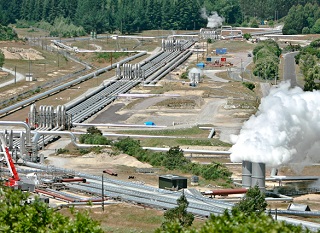From Guest Blogger Sean Casey: The Geothermal Energy Technology Revolution

As more and more people finally begin to take notice of the state of our planet, so it follows that businesses will start to invest in the manufacture of technology that will satiate the demand for greener energy supplies. Geothermal energy may not be news to those of us who have had an interest in such matters for some time, but the demand for a cleaner way of heating our homes and business premises is growing – even amongst those who were once skeptics.
This demand is driving the development of new geothermal energy technology, and it is resulting in advances that would have seemed fanciful just a decade or so ago. Although the very first dry steam geothermal power plant was constructed in Italy way back in 1904, the refinement of the technology over recent years has led to what many are now calling the Geothermal Energy Revolution.
Is It Viable At Scale?
The biggest problem associated with geothermal energy to date is its ability to create the amount of electricity required by modern cities. However, there have been some significant breakthroughs recently regarding this, not least of which is the progress being made with Enhanced Geothermal Systems (EGS).
EGS is not without its critics, but tests performed across sites in Bend, Oregon managed to crack hot rock to depths of 500 metres without anything more than microseismic events occurring. Previous concerns had been raised over the process in California and further afield in Switzerland with some opponents claiming that the deep probing was causing earthquakes. While the latest results seemingly show that EGS is manageable, tests are still being carried out to ensure the safety of the process.
If EGS is indeed deemed to be safe, the implications for the future of geothermal energy are huge. In fact, some experts claim that EGS could actually produce enough energy to run the entire electricity grid multiple times over.
What About Off-Grid?
For those who prefer to remain off-grid there have been some excellent advances too. Ground source heat pumps have become more reliable, more efficient, and cheaper to install over recent years.
Tapping into the earth’s natural underground thermal source is now a viable option for all, and the savings in your energy bills now easily offsets the cost of installation over the lifetime of the system. And, with energy prices constantly on the increase, the discrepancy between the initial outlay and the savings made is becoming smaller by the day.
The Future Of The Revolution
However, it is the larger scale practices such as EGS that are really exciting. While there is still a carbon footprint associated with geothermal energy, its impact on the environment is undoubtedly far smaller than the standard fossil fuels in use today.
New technology involving closed-loop water systems will lower the impact further still, making geothermal power plants even more efficient than the current open-loop operations available. The reuse of salient water from the geothermal wells in closed-loop systems would minimise emissions to the point where geothermal energy would become a serious contender against the coal-fired plants that we currently have in place.
About the Author:
Sean Casey is the director of Terra Therma. His company specialises in the installation of green energy solutions, such as underfloor heating and heat pumps, using the latest technology to provide the most efficient systems for his customers.

Very informative. I did not know that drilling down could cause earthquakes. Is there any evidence to support that? Is that opponents reaching for any reason to scare business owners away? I am a big proponent of geothermal in new construction homes. I am hoping the technology continues to advance to a point it makes more sense as a replacement system in current structures.